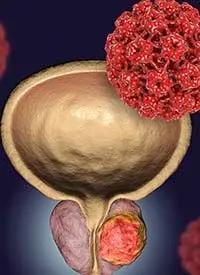Article
PSA response linked to improved survival with darolutamide triplet in mHSPC
Author(s):
Prostate Cancer

PSA response was associated with improved overall survival (OS) outcomes among patients with metastatic hormone-sensitive prostate cancer (mHSPC) treated with the triplet of darolutamide (Nubeqa), androgen deprivation therapy (ADT), and docetaxel, according to a post-hoc landmark analysis of the phase 3 ARASENS trial presented at the 2022 ASCO Annual Meeting.1
At 24 weeks’ follow-up there was a 53% (HR, 0.47; 95% CI, 0.35-0.63) reduction in the risk of death among patients who achieved undetectable PSA levels (<0.2 ng/mL) compared with those who still had detectable PSA. At 36 weeks, the reduction in the risk of death was 63% (HR, 0.37; 95% CI, 0.28-0.49).
Overall, the ARASENS trial (NCT02799602) enrolled patients with cytologically confirmed metastatic adenocarcinoma of the prostate. All participants had to be candidates for ADT and docetaxel, have an ECOG performance status of 0 or 1, and have adequate organ function.
Patients were randomized 1:1 to either 600 mg of daily darolutamide (n = 651) or matched placebo (n = 655) plus ADT/docetaxel. Factors for stratification included extent of disease (M1b/b/c) and alkaline phosphatase (ALP) levels. The primary end point was OS with secondary outcome measures of time to CRPC, time to pain progression, time for first symptomatic skeletal event (SSE), time to initiation of subsequent systemic antineoplastic therapy, and safety.
At baseline, the median PSA levels were 30.3 ng/mL (range, 0.0-9219.0) in the darolutamide arm and 24.2 ng/mL (0.0-11,947.0) in the placebo arm. Saad et al reported that at ASCO that darolutamide significantly extended the time to PSA progression vs placebo at a median of not evaluable vs 22.4 months, respectively (HR, 0.26; 95%, CI, 0.21-0.31; P <.0001).
Further, more than twice as many patients in the darolutamide arm vs the placebo arm achieved undetectable PSA at any time from randomization at 67.3% vs 28.6% respectively. The undetectable PSA rate continued to increase over time in the darolutamide arm while changing very little in the placebo arm: 24 weeks: 48.7% in darolutamide arm vs 23.9% in placebo arm; 36 weeks: 57.1% vs 25.1%, respectively; 52 weeks: 60.2% vs 26.1%, respectively.
Saad et al also noted that “baseline PSA and ALP levels were higher among patients who did not achieve undetectable PSA at any time post baseline.”
Regarding safety, Saad et al reported that, “Incidences of adverse events (AEs) were generally similar in patients achieving and not achieving undetectable PSA and by treatment groups, with a higher rate of drug discontinuations due to AEs among patients who did not achieve undetectable PSA at any time.”
Additional ARASENS data
Previously reported findings from the ARASENS trial showed that at a median follow-up of 43.7 months for darolutamide plus ADT/docetaxel and 42.4 months with placebo plus ADT/docetaxel, the median OS in the darolutamide arm was not estimable (NE; 95% CI, NE-NE) vs 48.9 months (95% CI, 44.4-NE) with placebo translating to a 32.5% reduction in the risk of death (HR 0.68; 95% CI 0.57-0.80; P <.001).2,3
Rates of OS at 48 months were 62.7% and 50.4%, respectively. The effect of active therapy was consistent across patient subgroups, including by ALP level below (HR, 0.64; 95% CI, 0.46-0.88) or above the upper limit of normal (HR, 0.69; 95% CI, 0.56-0.85), and by either de novo (HR, 0.71; 95% CI, 0.59-0.85) or recurrent (HR, 0.61; 95% CI, 0.35-1.05) metastatic disease status.
Moreover, darolutamide was associated with superior secondary outcomes despite patients in this arm receiving fewer subsequent life-prolonging systemic antineoplastic therapies (56.8%) vs the placebo arm (75.6%). Common subsequent therapies included abiraterone acetate (35.6% vs 46.9%), enzalutamide (Xtandi; 15.2% vs 27.5%), cabazitaxel (Jevtana; 18.1% vs 18.0%), and docetaxel (14.6% vs 18.0%). Notably, 66% of patients in the placebo arm went on to receive life-prolonging therapy with an AR pathway inhibitor. Time to first subsequent antineoplastic therapy was NE (95% CI, NE-NE) in the active therapy arm vs 25.3 months (95% CI, 23.1-28.8) in the placebo group (HR, 0.39; 95% CI, 0.33-0.46; P <.001).
A significant delay in time to castration-resistant disease was noted in the darolutamide vs placebo groups, at NE (95% CI, NE-NE) vs 19.1 months (95% CI, 16.5-21.8), respectively (HR, 0.36; 95% CI, 0.30-0.42; P <.001). Darolutamide was also associated with increased time to pain progression at NE (95% CI, 30.5-NE) vs 27.5 months (95% CI, 22.0-36.1) with placebo (HR, 0.79; 95% CI, 0.66-0.95; P = .01). Time to first SSE was NE in both arms, but statistically significant benefit with the darolutamide combination was noted (HR, 0.71; 95% CI, 0.54-0.94; P = .02).
Based on the results of the ARASENS trial, the FDA is currently reviewing a supplemental new drug application for darolutamide for use in combination with docetaxel for the treatment of patients with metastatic hormone-sensitive prostate cancer (mHSPC).
References
1. Saad F, Hussain MHA, Tombal BF, et al. Association of prostate-specific antigen (PSA) response and overall survival (OS) in patients with metastatic hormone-sensitive prostate cancer (mHSPC) from the phase 3 ARASENS trial. J Clin Oncol 40, 2022 (suppl 16; abstr 5078)
DOI: 10.1200/JCO.2022.40.16_suppl.5078
2. Smith MR, Hussain MHA, Saad F, et al. Overall survival with darolutamide versus placebo in combination with androgen-deprivation therapy and docetaxel for metastatic hormone-sensitive prostate cancer in the phase 3 ARASENS trial. J Clin Oncol. 2022;40(suppl 6):abstr 13. doi: 10.1200/JCO.2022.40.6_suppl.013
3. Smith MR, Hussain MHA, Saad F, et al. Darolutamide and survival in metastatic, hormone-sensitive prostate cancer. N Engl J Med. Published online February 17, 2022. doi: 10.1056/NEJMoa2119115
















